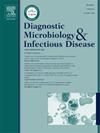"Is the Ceftazidime-avibactam plus aztreonam combination a solution for infections caused by metallo-β-lactamase producing carbapenem-resistant Enterobacterales? A call for further investigation"
IF 1.8
4区 医学
Q3 INFECTIOUS DISEASES
Diagnostic microbiology and infectious disease
Pub Date : 2025-09-12
DOI:10.1016/j.diagmicrobio.2025.117107
引用次数: 0
Abstract
Purpose
There are limited therapeutic options for carbapenem-resistant Enterobacterales (CRE). Ceftazidime-avibactam (CZA) is ineffective against metallo-β-lactamases (MBLs) like New Delhi metallo-β-lactamase (NDM). The synergistic combination of CZA and aztreonam (ATM) is a potentially useful option. This study evaluates the in-vitro efficacy and synergy of CZA-ATM against NDM CRE and proposes a practical and reliable screening test for CZA-ATM synergy.
Material and Methods
A total of 60 MBL-CRE were characterized for carbapenemases and in-vitro synergy of CZA-ATM using the gradient E-test strip (ESM) and the disc replacement method (DRM). CLSI breakpoints for ATM (MIC ≤4 µg/mL or zone diameter ≥21 mm) were used to define susceptibility for isolates showing CZA-ATM synergy.
Results
Among 60 CRE, blaNDM was detected in 53 isolates (88.3%). CZA-ATM synergy was detected in 40/53 (75.5%) NDM-CRE using the ESM and in 38/53 (71.7%) by DRM. Among the 7 non-NDM CRE, 4 (57.1%) showed synergy by both methods. Among 11/60 (18.3%) isolates, the MICs of ATM were >4 µg/mL when tested in combination with CZA. DRM showed excellent concordance with E-test with a sensitivity of 95.5%, specificity of 100%, and an agreement rate of 96.7% (κ = 0.96).
Conclusion
The CZA-ATM combination shows promising in-vitro synergy against 75.5% blaNDM-producing CRE. As significant number of isolates (18.3%) demonstrated ATM MIC ≥4 μg/mL when tested in combination with CZA, in-vitro testing should be performed to guide its clinical use. The DRM can be used as a reliable, cost-effective synergy test that can be easily incorporated in laboratory workflow.
“头孢他啶-阿维巴坦+氨曲南组合是否可以治疗产生碳青霉烯耐药金属β-内酰胺酶的肠杆菌引起的感染?”呼吁进一步调查”。
目的:碳青霉烯耐药肠杆菌(CRE)的治疗选择有限。头孢他啶-阿维巴坦(CZA)对新德里金属-β-内酰胺酶(NDM)等金属-β-内酰胺酶无效。CZA和aztreonam (ATM)的协同组合是一个潜在的有用选择。本研究评估了CZA-ATM对NDM CRE的体外疗效和协同作用,并提出了一种实用可靠的CZA-ATM协同作用筛选试验。材料和方法:采用梯度e试纸条(ESM)和圆盘置换法(DRM)对60个MBL-CRE进行碳青霉烯酶和CZA-ATM体外协同作用的表征。使用ATM的CLSI断点(MIC≤4µg/mL或区直径≥21 mm)来定义具有CZA-ATM协同作用的分离株的敏感性。结果:60株CRE中检出blaNDM 53株,占88.3%。采用ESM和DRM分别在40/53(75.5%)和38/53(71.7%)的NDM-CRE中检测到CZA-ATM协同作用。在7个非ndm CRE中,4个(57.1%)两种方法均表现出协同效应。在11/60(18.3%)株中,与CZA联合检测时,ATM的mic值为4µg/mL。DRM与E-test具有良好的一致性,灵敏度为95.5%,特异性为100%,符合率为96.7% (κ = 0.96)。结论:CZA-ATM联合用药对75.5%产blandm的CRE具有良好的体外协同作用。由于大量分离株(18.3%)与CZA联合检测时,ATM MIC≥4 μg/mL,需要进行体外检测以指导临床使用。DRM可以作为一个可靠的,具有成本效益的协同测试,可以很容易地纳入实验室工作流程。
本文章由计算机程序翻译,如有差异,请以英文原文为准。
求助全文
约1分钟内获得全文
求助全文
来源期刊
CiteScore
5.30
自引率
3.40%
发文量
149
审稿时长
56 days
期刊介绍:
Diagnostic Microbiology and Infectious Disease keeps you informed of the latest developments in clinical microbiology and the diagnosis and treatment of infectious diseases. Packed with rigorously peer-reviewed articles and studies in bacteriology, immunology, immunoserology, infectious diseases, mycology, parasitology, and virology, the journal examines new procedures, unusual cases, controversial issues, and important new literature. Diagnostic Microbiology and Infectious Disease distinguished independent editorial board, consisting of experts from many medical specialties, ensures you extensive and authoritative coverage.

 求助内容:
求助内容: 应助结果提醒方式:
应助结果提醒方式:


